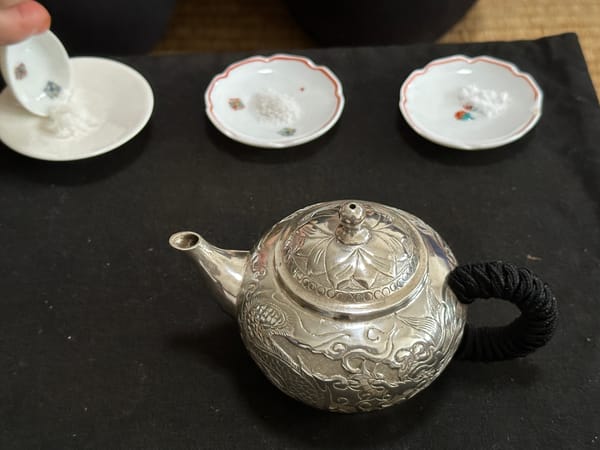Would you ever add salt to tea? For many, the idea might raise eyebrows. Yet this seemingly odd pairing was a common practice during the Tang Dynasty. Ancient tea drinkers not only added salt while boiling tea, but even had special utensils called yan tai (salt stands) for presenting this ritual. Today, this ancient wisdom is being revived—not only to reduce bitterness, but to enhance the lingering sweetness of tea. Let’s revisit the Tang Dynasty’s tea culture with modern taste buds, and explore new possibilities with a pinch of salt.
Why Did Ancient People Add Salt to Tea?
Before the refined brewing methods of today, Tang Dynasty tea preparation was entirely different. Tea leaves were ground into powder and boiled directly, often resulting in bitterness. The clever solution? Add a touch of salt to bring out umami and roundness in the flavor.
Tang Tea Culture and Mentions in the Classic of Tea
The tea sage Lu Yu documented this method in his famous Classic of Tea (Cha Jing):
"When it first boils, add salt in the right amount to adjust the flavor."
This was no random act—it was a carefully practiced technique based on observation and experience.
Summary: Adding salt to tea in the Tang Dynasty was a deliberate, evidence-based method to reduce bitterness and enhance flavor.
Yan Tai: The Ritualistic Salt Stand of the Tang Tea Table
Salt was not casually tossed into tea; it was part of a refined ritual. In 1987, archaeologists discovered a silver tripod salt stand with Makara motif in the Tang Dynasty underground chamber of Famen Temple in Shaanxi. This exquisite item was used to serve salt during formal tea gatherings.
The stand’s lid was shaped like an overlapping lotus leaf, adorned with banana leaf engravings and a mythical sea creature motif. Lifting the lid revealed a lotus-pod-shaped opening for holding salt. Lu Yu also described such vessels:
"Salt vessel, made of porcelain, about four inches wide, shaped like a cup or jar, used for storing salt flowers."
Summary: The salt stand (yan tai) was a formal and symbolic element of Tang tea ceremonies, showing the importance of salt in tea rituals.
How Salt Works: A Modern Scientific Explanation
Today, science offers a clear explanation of why salt improves the flavor of tea. Chemistry professor Michelle Francl notes that sodium ions block bitter taste receptors on the tongue, reducing the bitterness of tea and enhancing its drinkability.
How Sodium Suppresses Bitterness
This effect is known as mutual suppression—where saltiness reduces perception of bitterness or acidity, making sweetness more prominent. Everyday examples include:
- Adding salt to watermelon makes it taste sweeter
- A pinch of salt on grapefruit reduces bitterness
- Some baristas add salt to overly bitter coffee to balance the flavor
Summary: Sodium ions interfere with bitter receptors, scientifically validating the ancient practice of salting tea to enhance its balance and umami.
How to Experience Salted Tea Today
While the Tang Dynasty’s boiling method has faded, we can still revive this wisdom through modern tea experiences. Here are some practical ways to explore:
Best Tea Types to Try with Salt
Not every tea suits salt. Try these first:
- Green tea – Dragon Well, Biluochun: a tiny pinch enhances brightness and cuts sharpness
- Oolong tea – Heavily roasted varieties benefit from a touch of salt to smooth bitterness
- Raw Pu-erh – Young sheng pu-erh often tastes bitter; salt balances the profile
Salt Types and Flavor Profiles
Different salts yield different taste experiences:
| Type of Salt | Best With | Flavor Impact | Ideal Scene |
|---|---|---|---|
| Fleur de sel | Dragon Well, Biluochun | Enhances umami, subtle balance | Light green & white teas |
| Himalayan salt | Aged oolong | Mineral-rich, fuller body | Roasted teas, ripe pu-erh |
| Lake salt | Pu-erh, black tea | Slight earthiness blends with depth | Bold or warming teas |
Summary: Matching the right tea with the right salt is essential for unlocking this ancient flavor pairing.
How to Begin Your Salt + Tea Experiment
Ready to try? Follow these simple steps:
- Choose your tea wisely: Begin with a bright green tea like Dragon Well
- Start with a fine salt: Use sea salt or fleur de sel for subtlety
- Taste mindfully:
- First, sip the plain tea
- Place a tiny grain of salt on your tongue
- Sip again and compare
- Alternatively, dissolve 0.2g salt in 100ml tea and observe the difference
- Track your impressions: Note changes in bitterness, sweetness, and umami
Summary: Start with micro-amounts and observe your taste evolution—the salted tea journey is one of patience and personal discovery.
One Cup, One Pinch: A Philosophy in Flavor
The fusion of tea and salt is more than sensory pleasure—it’s a reflection of life. As poet Pi Rixiu once described the joy of tea in Tea Verses – Boiling Tea:
"Fragrant spring mixed with milk, boiling into pearl-like bubbles; crab-eye bursts, then fish-scale ripples rise."
In life, just a hint of seasoning can transform the ordinary. Tea and salt—two humble ingredients—when brought together in harmony, reveal surprising depth.
Perhaps that’s the philosophy of flavor: wonder within the plain, beauty in the balanced.
One tea. One salt. Sip slowly, feel fully.
A quiet, unexpected joy awaits in every cup.


